|
Route history
Dating originally from 1920, when it ran between South Harrow
and Stanmore, the 140 had a chequered history of operation in the
Harrow and Edgware area until withdrawal in 1927.
Re-introduced in a new form in 1932 to
run from Colindale via Kenton and Harrow to Northolt, the route was
augmented in its first summer to serve the RAF displays at Hendon
Aerodrome. Major changes to the route have been
infrequent. The first was in 1936, when the route was
diverted at Kenton away from Colindale to run north then east to
Mill Hill, terminating at Bunns Lane, short of the low bridge at
Mill Hill Broadway.
Initial operation was
by STs, briefly alongside STLs from AC during the mid-30s, with
STLs taking over fully in 1939. In 1950 the 140, with the
114, was an early RTW route before these 8-footers took their
rightful place in central London; for the short period that these
buses were used on Police trials before their use was authorised,
they were replaced at Harrow Weald by RTLs.
Meanwhile, the route was extended further south, to Hayes in
1937 and Heathrow Airport (then 'London Airport Central') in
1955. With the lowering of the road under the railway at Mill
Hill in 1967, the route was extended slightly to terminate at
the new bus station under the new M1 and some Monday to Friday
journeys were extended eastwards, to Page Street in 1967 and
to Mill Hill East in 1968.
Apart from its first few months, when the
route was operated by Willesden garage, the route worked
continuously from Harrow Weald (HD) until 1990. Other
garages have assisted from time to time, including Hendon (AE),
Edgware (EW) and Willesden (AC) again.
The transfer of the RTWs during 1951 brought
RTs from HD and RTLs from EW, the latter in turn replaced by RTs
the following year through until 1966, from when weekday operation
was by HD alone. Having been originally planned for 1962 but
deflected by union opposition, Routemasters did not arrive at HD
until July 1978, when the RTs were finally replaced. Their
last day on 14 July 1978 marked the last RT operation in west
London.
Routemasters, in the longer form of the RML,
had worked the 140 from AE on Sundays since 1972,
and continued alongside HD's standard RMs until the end of
crew operation. The 140 had been the only crew route at HD
since late 1971, this and its 7-8 minute frequency underlining its
status as a trunk route.
On conversion to one-person operation in 1983,
the route was diverted at Harrow to run to Harrow Weald, swapping
the eastward section with the 114, which provides the service to
Mill Hill today. The 140 from Heathrow to Harrow Weald
has continued broadly unchanged since then.
Harrow Weald operated M-class
Metrobuses from 1983. Following the introduction of
tendering in 1985, the first tender for the 140 was won by Harrow
Buses, a low-cost operation of London Buses, in 1987. In
addition to Ms, the route saw hired Manchester Fleetlines, V-class
Volvo Ailsas and even single-deck Leyland Nationals.
The contract passed in 1990 to
another LBL operation, London United at Hounslow, also operated
with Metrobuses, followed from 1996 by L-class Olympians. In
1999, the contract returned 'home' to HD, by now operated by
Metroline. The buses were TA then TPL-class Tridents,
replaced in 2006 by Volvo Presidents, a single example of which
still operates the route from HD alongside Volvo Gemini 3s.
Acknowledgements
London Bus Museum would like to express its appreciation to
Metroline, operators of the 140 and of Harrow Weald Garage, TfL for
their assistance and support, Heathrow Airport Ltd, for permission
to use Central Bus Station, and above all, the owners of preserved
buses for their willingness to put them through the rigours of
London operation once again.
Previous
re-creation
The 140 operated between Mill Hill
East and Harrow Weald Garage at the Red-RF Colindale event in 2010. The
route also featured at Timebus's 20th
birthday running day in 2007.
Service
information
This free service is not operated by
Transport for London (TfL) or London Buses. Passengers travel
at their own risk and at the discretion of the crew. Times
are published as a guide to the general pattern of service. Whilst
every effort will be made to keep to the timetable, the London Bus
Preservation Trust Ltd. will not be held responsible for any loss,
damage or inconvenience caused by reason of any operating failure,
within or beyond our control.
|
|
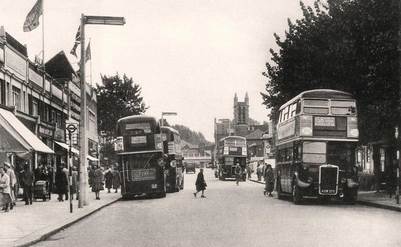
RTWs in College Road, Harrow, in about 1950,
including RTW195 on the 140.
Photo Chris Stanley Collection
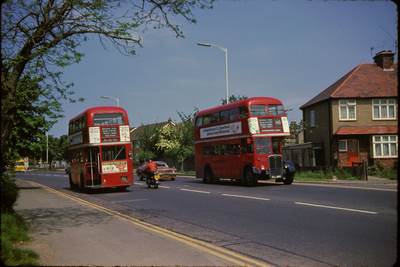
RT651, displaying a front via blind in the rear
box, passes RT4779 in Yeading Lane.
Photo © Kevin McCormack
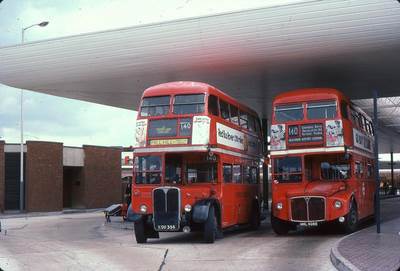
RT2327, working from HD, passes RML2608,
working from AE, at Heathrow Central Bus Station, which in
those days had a roof. The RT carries both RT and RM blinds
for the special Sunday working via Cherry Lane Cemetery, as well as
a canopy blind in the main number box. Towards the end, there
were clearly RT blind shortages.
Photo © Fred Ivey
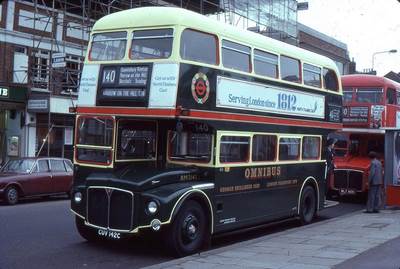
RM operation finally arrived on the 140 in July
1978. In March 1979, commemorating Shillibeer's 1829
horsebus, RM2142 is followed in Harrow by standard RM905.
Photo © Fred Ivey
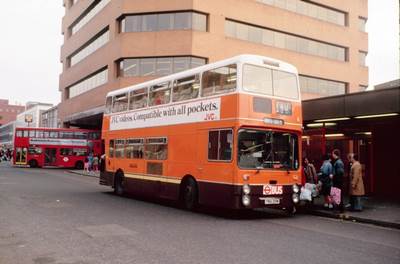
When the 140 was re-routed to Harrow Weald in
1983, by swapping its northern section with the 114, Metrobuses
replaced RMs. In 1987, at the first tender route for the
route, London Buses retained the contract through their Harrow
Buses operation at HD. Although scheduled for
Metrobuses, the route regularly saw hired Greater Manchester
Fleetlines. 7360 is seen here at Harrow Bus Station.
Photo © NLCadge, 433shop.co.uk
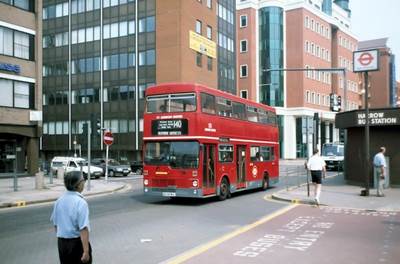
In 1990, London Buses' London United operation
won the contract, again using Metrobuses, operating from Hounslow
(AV). In 1992, M1238 is seen in the same
location.
Photo © NLCadge, 433shop.co.uk
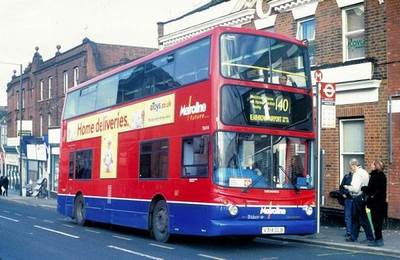
After return of operation to Metroline at HD,
TA114 stops by Harrow & Wealdstone Station.
Photo © NLCadge, 433shop.co.uk
|